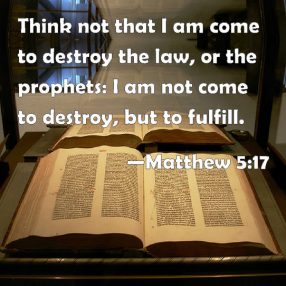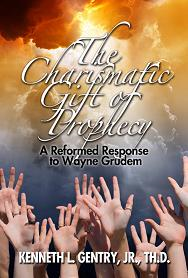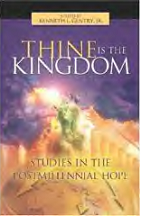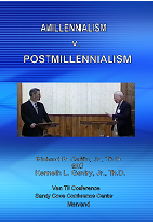BAHNSEN AND MATTHEW 5:17
PMW 2023-065 by Kenneth L. Gentry, Jr.
Sadly, many challenges against Greg Bahnsen’s Theonomy in Christian Ethics (TCE) are based on mistaken assumptions rather than careful observations. This is the case with one of Bahnsen’s loudest critics, Dr. T. David Gordon who wrote his “Critique of Theonomy: A Taxonomy” (CT).
Gordon’s “Critique” opens with a few comments on polemics, noting potential areas of difficulty (CT, 23). He recognizes (as we all should) that our polemics can be undercut by “whatever is untrue, unclear, or unhelpful” (CT, 25). Unfortunately, by overstating his case he inadvertently succumbs to that which is “untrue, unclear, or unhelpful.”
Gordon’s first point in this section of his critique is blunted by his exaggerated claims regarding Bahnsen’s dependence on Matthew 5. He writes: “Paul Fowler correctly observed that Bahnsen’s entire case for his approach to the ‘abiding validity of the law in exhaustive detail’ was based upon his understanding of Matt 5:17–21. . . . If Bahnsen cannot make his case from this text, his case is not made” (CT, 28). One supporting evidence for Fowler’s statement affirmed by Gordon is: “Fowler pointed out how frequently this passage is cited in Theonomy in Christian Ethics as proof of the observation” (CT, 28).

Covenantal Theonomy
(by Ken Gentry)
A defense of theonomic ethics against a leading Reformed critic. Engages many of the leading objections to theonomy.
See more study materials at: www.KennethGentry.com
Because Gordon did not make the effort to check whether Bahnsen might have responded somewhere along the way to his critics on this supposed problem, he is not aware of how Bahnsen counters such objections. This is all the more remarkable because of the enormous volume of critiques of Bahnsen — and because Theonomy itself confronts it. As Gordon surely knows, resistance to theonomic ethics has spawned widespread and prolonged rebuttals in presbytery debates, public symposia, lengthy articles, and whole books. We know that Gordon is aware of this immense backlash against Theonomy, after all, he took the time to jump into the fray and cites several of the objectors in offering his “taxonomy” on the matter.
In No Other Standard Bahnsen alludes to various foundational texts, when he responds to a particular critic. He complains that the critic rebuts the theonomic argument “only after the main supporting texts for the theonomic view (viz., Matthew 5:17-19 and Romans 13:1-7) have been removed from consideration” (NOS, 163). Notice that Bahnsen himself declares that there are “main supporting texts” (plural), and even cites one of them in addition to Matthew 5: Romans 13.
In another place, Bahnsen parallels 2 Timothy 3:16-17 with Matthew 5:17 as a key text: “Jesus warned against dismissing even the least Old Testament commandment (Matt. 5:19), and Paul taught that every Old Testament scripture instructs us in righteousness (2 Tim. 3:16-17)” (NOS, 99). In fact, 2 Timothy 3:16-17 is a favorite text for Bahnsen, which he often cited along with Matthew 5. For example: “Nor is it clear how this restriction can be harmonized with the New Testament endorsement of every scripture (2 Tim. 3:16), every command (James 2:10), even the least command (Matt. 5:19), every word (Matt. 4:4) and every letter (Matt. 5:18) of the Old Testament” (NOS, 125). Obviously, Bahnsen focuses on a variety of foundational biblical texts — though Matthew 5 remains the key one among them.
Why does Gordon not suppose that somewhere along the way Bahnsen would provide counter-evidence on the objection that his whole argument rests solely on one text? Was not Bahnsen a philosophically-trained debater (he earned a Ph.D. in philosophy from the University of Southern California and has several public debates on tape)? Did he not possess an “over-heated typewriter” (Kline’s derogatory statement regarding Bahnsen’s prodigious output)? Was he not subjected to relentless criticisms regarding his theonomic ethics? According to Gordon himself, did not Theonomy generate “an intellectual movement” (CT, 43)? Why would he not think it likely that the movement had dealt with such a complaint? This is especially problematic in that Gordon was offering a rigorous, academic response to Bahnsen and in a respected Reformed theological journal.
In point of fact, Bahnsen does respond to this very objection in Strickland’s The Law, the Gospel, and the Modern Christian. Bahnsen answers Strickland thus:
“He makes a weak effort in this under his discussion of ‘The Mosaic Law and the Christian,’ starting off with a misbegotten attempt to reduce how much effort would be needed for the task. First, Strickland tries to reduce the theonomic position to Matthew 5:17-19 (calling it ‘the major justification for theonomy’). . . . Ah, would that it were so easy! The fundamental operating premises of Theonomic Ethics could be — indeed, in my books, are — readily proven from any number of New Testament passages, only one of which is Matthew 5:17-19. . . . The theonomic thesis could be demonstrated without any reference to this text at all.”
Gordon fumbles here by employing Fowler’s older study, released in 1979, and then again in 1980 (after changing it radically due to Bahnsen’s devastating response).
Interestingly, in his “Conclusion” to Theonomy Bahnsen only mentions Matthew 5 in one place, and that only as a closing motto (TCE, 476). In fact, he declares in his six page conclusion: “The theonomic ethic is substantiated in multiple ways throughout the pages of the New Testament” (TCE, 474).
 God’s Law Made Easy (by Ken Gentry)
God’s Law Made Easy (by Ken Gentry)
Summary for the case for the continuing relevance of God’s Law. A helpful summary of the argument from Greg L. Bahnsen’s Theonomy in Christian Ethics.
See more study materials at: www.KennethGentry.com
In his later Preface to the second edition of Theonomy (1983) Bahnsen provides a ten point statement “that draws tegether, clarifies, and states in distilled form the vital teachings elaborated in the full text of Theonomy in Christian Ethics” (TCE, xxv). Not one of these ten points either alludes to Matthew 5, references it, or quotes words or phrases from it. This is contrary to Gordon’s assertion that “if Bahnsen cannot make his case from this text, his case is not made” (CT, 28).
Elsewhere Bahnsen expressly denies that Theonomic Ethics rests solely on Matthew 5. In responding to Reformed theologian Paul G. Schrotenboer, he comments on the role of plerosai (“fulfill”) in Matthew 5:17 for his argument. He not only states that this important aspect of Jesus’ declaration is not “in any way essential to its [Theonomy’s] argumentation,” but he believes “the debate over how to translate or interpret that Greek word is really irrelevant.” This does not sound like a statement from someone who case “cannot be made” apart from this passage.
In No Other Standard Bahnsen states:
“Did Jesus assume basic continuity or basic discontinuity between His ethic and that of Moses? In asking whether we should presume that the old covenant law is binding or abrogated today, one relevant and important passage which cannot be avoided is Matthew 5:17-19. Thus it was given detailed attention in my book Theonomy in Christian Ethics, even though it is not the only text which could be used to substantiate the theonomic operating premise.” (NOS, 273, emphasis mine)
Thus, even though Gordon complains: “If Bahnsen cannot make his case from this text, his case is not made” (CT, 28), Bahnsen himself writes: the “theonomic operating premise” is not “substantiate[d]” on this one “text” (NOS, 273).
In fact, the evidence for Gordon’s statement is based on Fowler’s research: “Fowler pointed out how frequently this passage is cited in Theonomy in Christian Ethics as proof of the observation” (CT, 28). If Fowler’s research method is followed consistently, though, we could actually reach the opposite conclusion, for Theonomy’s Scripture index contains thirteen pages of three column references to the New Testament (TCE, 597-610), of which less than a page of them index Matthew 5.
Contrary to Gordon, then, Matthew 5 is Bahnsen’s locus classicus, not his sine qua non.
Yet theonomists gladly affirm that Bahnsen does emphasize Matthew 5:17-21 as a key passage in establishing the presumption of continuity between the Old and New Testament ethical standards. So then, despite his tendency to overstatement, if Gordon could demonstrate that Matthew 5 was woefully mishandled in Theonomy, he would have significantly impaired Bahnsen’s argument — at least as it is presented in Theonomy in Christian Ethics. But he would not have destroyed the entire foundation to the theonomic system. To be sure, Bahnsen certainly never backed off of his emphasis on the passage; thus, his exegesis is fair game for criticism (unlike with Gordon’s first criticism).
Click on the following images for more information on these studies:



Kenneth L. Gentry Jr.'s Blog
- Kenneth L. Gentry Jr.'s profile
- 85 followers



